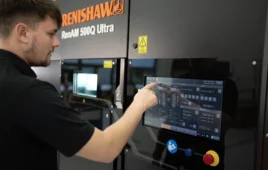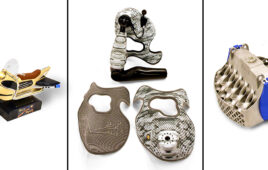The BLOODHOUND Project is an international education initiative focused around a 1,000 mph World Land Speed Record attempt. The core aim is to inspire young people to pursue careers in Science, Technology, Engineering and Mathematics (STEM subjects) by showcasing these subjects in exciting ways. The Project Director is Richard Noble and the Program Architect is Dan Johns.
This car will be powered by a jet engine and a rocket as it attempts to go at least 1,000 mph. Key parts of the car were designed using 3D printing and additive manufacturing (AM) technologies.
This “ultimate racing car,” according to some, is a fusion of cutting edge science and engineering. One of the reasons 3D printing was chosen was to reduce material waste. To machine a component from a billet of aluminum can produce 80% waste. The equivalent produced using AM creates just 6% and removes the energy hungry process of manufacturing the billet.
BLOODHOUND engineers are using additive manufacturing in several crucial components, including:
• the steering wheel,
• the Auxiliary Power Unit (APU) gearbox housing,
• the high load parachute strop brackets
• and the bolt fixtures that will hold the carbon fiber front end to the metallic rear chassis.
The prototype steering wheel
The steering wheel forms the vital contact point between driver Andy Green and the Hakskeen Pan, a desert area in the North Western corner of South Africa, streaking below him at 3.6 seconds per mile. The grips on the W shaped wheel will be specially molded to his hands and manufactured from powdered Titanium. This complex hollow design could not be produced in one piece using conventional manufacturing methods. The prototypes were manufactured from powdered nylon by Materalise.
To develop a robust steering wheel design, concepts were crowd sourced from dozens of product design students at the University of Lancaster. BLOODHOUND’s Dan Johns set them the challenge to think creatively about a steering wheel that had no manufacturing constraints, and they responded with innovative designs that the BLOODHOUND engineers are incorporating into the final component.
The gearbox casing
Although BLOODHOUND is powered by an EJ200 Eurofighter jet engine and a custom built Falcon hybrid rocket, it requires a gearbox to control the 750 bhp from an Auxiliary Power Unit. Cosworth’s CA2010 F1 engine is used to drive the hydraulics and the pump that delivers one ton of Oxidiser into the Falcon hybrid rocket in just 17 seconds. The CA2010 F1 engine produces full power at a staggering 18,000 rpm, about three times faster than a regular car. This needs to be stepped down to the optimal speed of 10,000 rpm for the Oxidiser pump, so a custom gearbox was developed using Xtrac gears, AP Racing clutch and gearbox hydraulics. “We wanted to start validating the use of Titanium Additive Manufacturing on a non-safety critical component, to build our confidence towards using the technology on more critical pieces,” said Johns, “The gearbox casing was successfully manufactured by Arcam.”
Recently, those involved in the project distributed the CAD design drawings to more than 4,500 schools and colleges across the UK where they can be accessed by over 1.5 million students, and to extended fans and enthusiasts following the Project in the 207 countries around the world.
John Wood, President of the Institution of Mechanical Engineers said: “It’s unprecedented to release detailed design data from a project like this, yet it’s part of the unique appeal and importance of BLOODHOUND to demonstrate how sophisticated engineering works.”
Mark Chapman, BLOODHOUND Chief Engineer, added, “If you had a spare jet, rocket and F1 engine, you could, in theory, use these drawings to build your own BLOODHOUND at home. Much as we enjoy a good race, we don’t recommend it. Things get pretty hairy when you travel faster than a bullet!”
The downloadable 3D design drawings, which make up the car’s genetics, are the result of 30 man-years of cutting-edge research and design work. Comprised of 4,000 individually designed components, you can deconstruct the CAD model layer by layer, rotate on all axes and zoom in and out, using professional engineering software from Siemens.
The 3D design drawings allow viewers to explore the remarkable engineering that allows BLOODHOUND SSC to accelerate from 0 -1050 mph and back in just 100 seconds and safely handle the phenomenal forces and loads acting upon it: the 47,000 lb thrust generated by its jet and rocket engines; 30 ton suspension loadings; air pressures on the bodywork of up to 10 ton per square meter; the air brakes each exert 2.2 tons as they open; solid aluminium wheels alone weigh 90 kg each and will be spinning at 10,200 rpm, generating 50,000 radial g at the rim.
World Land Speed Record breaking is bound by a few rules, namely: the car must be continuously controlled by a driver, run on at least four wheels and make two passes through the measured mile within one hour. This means that land speed record challengers enjoy almost total freedom when designing their car and it explains why, in 1997, Thrust SSC, a four-wheel twin jet-engined car, was able to race Craig Breedlove’s single-engine, five-wheeled Spirit of America. Physics levels the playing field, not a book of regulations.
The 3D design drawings will be used extensively in the BLOODHOUND Education Program, which produces curriculum ready resource materials for all levels of education. Currently 4,081 primary and secondary schools, 246 further education colleges and 42 universities, encompassing 1.5 million students, have been exposed to real-world case studies based on the jet- and rocket-powered Car, helping to bring their Science, Technology, Engineering and Maths (STEM) lessons vibrantly to life.
After 36 months of detailed design work, refined versions of these design drawings have been issued to key BLOODHOUND suppliers including Hampson Industries Plc, who will shortly commence cutting the first steel and aluminium to fabricate the rear chassis. Meanwhile, Cosworth Ltd are close to completing preparation of their Formula 1 racing engine and software package ready for the largest rocket test the UK has seen in 20 years – due to take place this Summer.
And for those of you who feel “the need for speed,” take a look:
Bloodhound SSC
Filed Under: Brakes • clutches, Hydraulic equipment + components, 3D printing • additive • stereolithography, Make Parts Fast




